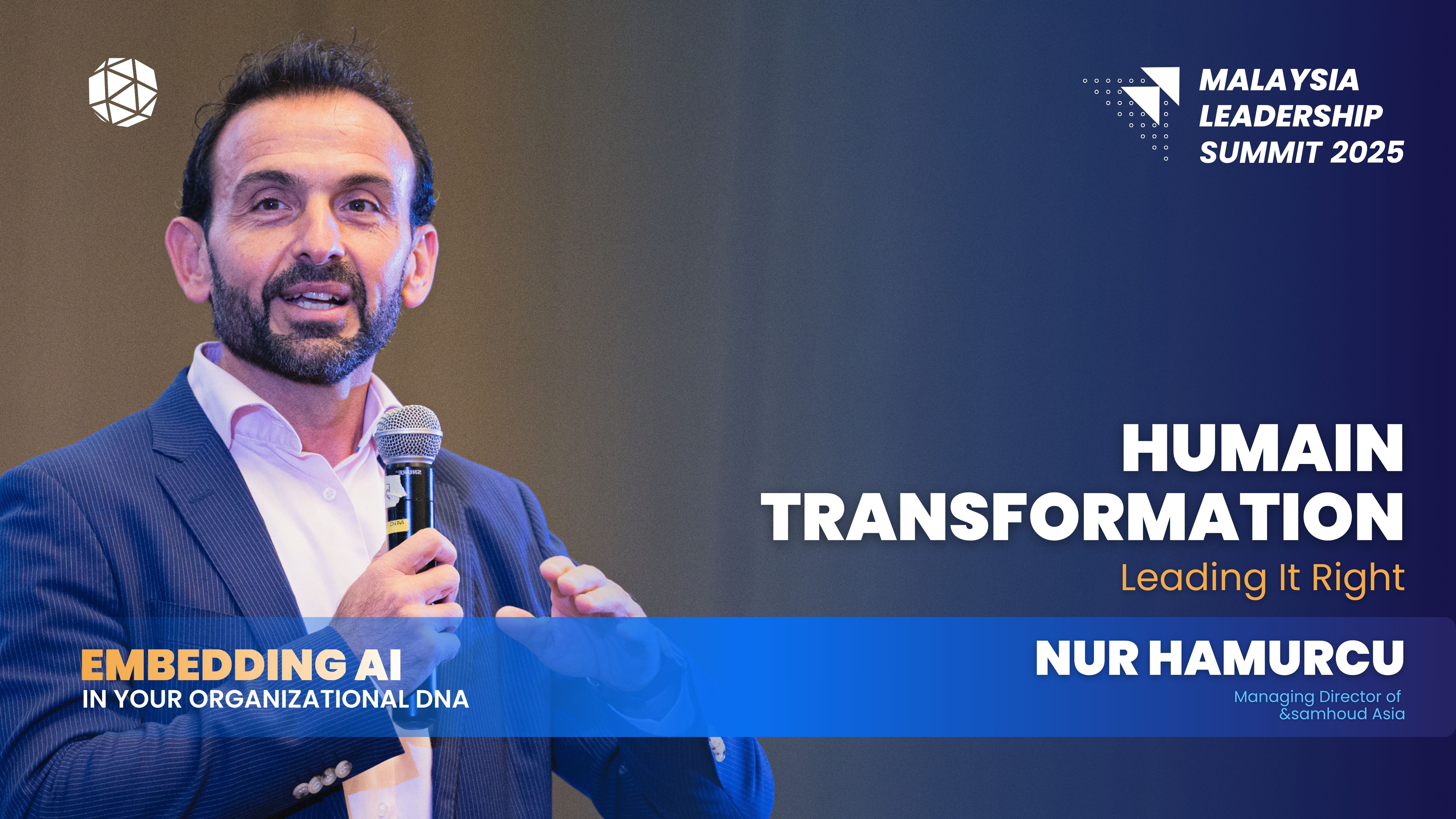Courageous Leadership in the Age of AI: Key Insights from The Malaysia Leadership Summit 2024 (Part 2)

Tareef Jafferi, Wong Xiao Qing and Kris Uttraphan (left to right) I Malaysia Leadership Summit 2024
The second part to our series on The Malaysia Leadership Summit 2024, here offer diverse perspectives and practical strategies to navigate this evolving landscape. From mastering leadership through neuroscience and AI, to fostering resilience, compassion, and effective communication, these insights equip leaders with the tools needed to stay ahead. This Summit was sponsored by Sime Darby Property Berhad and organised by Leaderonomics, Malaysia HR Forum and Together We Can Change The World.
In case you missed Part 1 to this series, click here.

Jana Stanfield from Together We Can Change The World
Mastering Leadership : Profiting with Neuroscience & AI by Dr. Avi Ratnanesan
The reality we face is daunting. We live in a world plagued by conflict, not just in geopolitical hotspots like Russia, Ukraine, or the Taiwan Strait, but within the minds of business leaders everywhere. A silent battle rages as executives question who they can trust — their own instincts or the data-driven decisions suggested by AI. This internal conflict is universal, affecting decision-makers across all industries and regions. As technology continues to transform the external world, the more pressing concern becomes our internal struggle: where will we seek answers in the future?

Participant interacting with Dr. Avi's clone I Dr. Avi Ratnanesan
To address these complex challenges, Dr. Avi propose a new leadership model that integrates the strengths of both neuroscience and AI — what Dr. Avi calls Neuroscience and AI Enhanced Leadership, or N.A.I.L. This system is designed to help leaders optimise their decision-making processes in real-time, combining the unique capabilities of the human brain with the precision and speed of artificial intelligence. By understanding how the brain functions, we can make more informed decisions that directly influence business outcomes, whether it’s enhancing team performance, improving customer engagement, or driving profitability.
The N.A.I.L. system empowers leaders to navigate today’s volatile business environment by making decisions that are not only quick but also strategic. For instance, in a world where the average organisation relies on 400 data sources before making a decision, the ability to filter, process, and act on the most relevant information is crucial. With AI, Dr. Avi is of the opinion that leaders can gain insights that were previously inaccessible, allowing them to make better decisions faster. Moreover, this system helps leaders prioritise tasks and manage multiple competing priorities by providing real-time recommendations based on the latest data and cognitive science.
Implementing N.A.I.L. also addresses the challenge of inconsistent team performance. By using AI to identify the specific needs and strengths of each team member, leaders can tailor their approach to maximise productivity and motivation. This system can even predict potential obstacles and suggest proactive measures, ensuring that teams remain aligned and focused on achieving their goals. Furthermore, N.A.I.L. supports leaders in fostering an environment of continuous learning and development, where both leaders and their teams can adapt to new challenges with agility and confidence.
Ultimately, the N.A.I.L. system represents a transformative approach to leadership, one that combines the best of human intuition with the power of AI. This is not just about keeping up with change; it’s about staying ahead of it, leveraging the most advanced tools available to make smarter, more effective decisions that lead to sustained success.
The Explorer’s Way : Leading in an Unsettled Age by Jega Manoharan
About two years ago, Jega found himself at the helm of a major project within a large financial institution. The company, undergoing rapid changes due to automation and technological advancements, faced the tough reality of job redundancies. Many employees had been with the organisation for over two decades, their skills deeply specialised and aligned with roles that were now becoming obsolete.
Jega’s task was to develop a redeployment program to help these long-serving employees transition into new roles. However, the challenge was far greater than anyone anticipated. Despite creating a robust development program to build new competencies, there was a tangible sense of bitterness and resistance. These employees had built their careers on a specific set of skills, and now they felt abandoned and uncertain about their future. Even with all the resources and support offered, it was too late for many to adapt, highlighting the importance of proactive planning and empathy when navigating workforce transformations. With rapid changes in AI, politics, and the global economy, we need to consider how we will engage with our employees in and what kinds of mindsets we will cultivate within the organisation.
In every organisation, two predominant mindsets emerge: the settlers and the explorers. Settlers operate within established boundaries and rules, ensuring stability and order, while explorers thrive on curiosity and a desire for discovery. The settlers provide the necessary structure, but their adherence to rules can stifle innovation. As leaders, we often find ourselves comfortably nestled in our established settlements, but to foster growth and innovation, we may need to take a "leap of necessity" into uncharted territory. This leap is essential not only for discovering new opportunities but also for encouraging a culture where exploration is valued alongside stability.

Settler vs. Explorer I Jega Manoharan
Jega invited the participants to reflect on their experiences when they all started on their career path. At the beginning most people start their careers as explorers, filled with energy and excitement for new challenges. Over time, as we gained power and responsibilities, we often shifted our focus from strength to maintaining our positions. This shift can lead to a fear of taking risks and a reluctance to explore new possibilities. However, we must realign our focus on building strength and fostering a culture of discovery. By doing so, we can ensure that our organisations remain adaptable and resilient in the face of change.
Jega encourages, as we look ahead, it’s vital to cultivate an explorer's mindset, embracing curiosity and the necessity to take risks in order to thrive in an ever-evolving landscape.
Influence Through Voice in Times of Uncertainty by Cynthia Zhai
In a chaotic and uncertain world, having a voice that projects trust and calmness is a valuable leadership skill. A comparison is made to Morgan Freeman's trustworthy voice, which instantly compels people to listen and trust. For leaders, the goal is to sound credible and reassuring, regardless of internal turmoil or nerves. Learning to control the physical aspects of your voice—breath, pitch, and tone—can help in achieving this. A shaky, high-pitched voice signals nervousness, but with practice, you can convey calm even if you don't feel calm internally. Cynthia Zhai shares three key techniques to help leaders master their voice under pressure.

Your breath is your life force I Cynthia Zai
The first technique revolves around proper breathing, often referred to as “kung fu breathing.” Many of us have been breathing improperly for years, using shallow breaths that do not engage the diaphragm. To practice kung fu breathing, focus on diaphragmatic breathing—when you inhale, your stomach should expand, and when you exhale, it should contract. This style of breathing helps you maintain control over your voice, giving it a deeper, more resonant quality. Think of your breath as the life force behind your voice; mastering it will help you sound more powerful and grounded.
The second technique is the “Joyful Sigh,” a simple yet effective exercise to release tension and relax the voice. By letting out a relaxed sigh, you can feel how voice projection should be—effortless and natural. Regular practice of this exercise allows you to project your voice without strain, helping you sound more composed and in control. This exercise is essential to avoid physical fatigue or a sore throat during extended periods of speaking.
Lastly, to influence people emotionally through your voice, it's crucial to adapt your breath to express different emotions. For example, assertiveness can be conveyed with a strong, short breath, while empathy can be shown with slow, steady breathing. These breathing patterns reflect the emotional state you're trying to project, making your communication more impactful.
So, the key takeaway for leaders is to focus on the breath to master their voice, thus helping them sound calm, assertive, and empathetic, even when faced with challenging situations.
Leading with Courage and Compassion, and AI: The Future of Empowered Leadership by Jonathan Low
What does it take to lead with courage? Research conducted by a Harvard Business educator, Professor Nancy Koehn emphasises the importance of leaders demonstrating courage. In a survey, nearly 75% of participants highlighted courage as a crucial trait for leadership.

Courage + Compassion x by AI (agility and influence) = Empowered Leadership I Jonathan Low
The research further identifies five characteristics of courageous leaders: authenticity, resilience, emotional intelligence, self-discipline and commitment to purpose. These traits are essential for effective leadership. Mr. Jonathan Low encouraged the participants to think about which areas they excel in and where they might need improvement in. Some of the commonly found primary barriers to courageous leadership include fear of failure, resistance to change, and a culture that does not support innovation. These challenges may sound familiar, but overcoming them is essential for growth and success.
Another critical aspect of courageous leadership is resilience. “Resilience is not just about bouncing back; it's about rising higher each time you do”. Take the example of NBA player Steph Curry from the Golden State Warriors. Despite not being the tallest player, he has consistently found innovative ways to succeed, culminating in his fourth NBA championship in eight years. His story, as depicted in the documentary "Underrated," illustrates the power of resilience. Curry's journey reminds us that success is not just about talent; it's about persistence, adaptation, and the courage to face challenges head-on.
Participants were asked to think about their journey, whether in embracing AI or any other venture to consider the importance of resilience. Resilience allows you to navigate through tough times and emerge stronger. It's about maintaining a growth mindset and challenging the status quo, even when the odds seem insurmountable.
How about the importance of compassion in leadership? A survey revealed that nearly 88% of participants believe compassion is a crucial quality for leaders. Yet, despite its importance, only 76% of these organisations actively support a culture of compassion and emotional intelligence. Compassion in leadership goes beyond empathy; it requires action. Empathy involves understanding others' thoughts and feelings, but compassion demands that we take steps to help others based on that understanding.
Compassionate leadership is about blending your thoughts, feelings, and actions to make better decisions. This approach not only builds trust but also fosters collaboration within your team. As you develop a culture of trust, consider qualities such as competence, reliability, accountability, credibility, and empathy. These attributes are essential for building and maintaining trust within your organisation.
In conclusion, as we look towards the future of leadership, consider the formula: Courage + Compassion, multiplied by AI (agility and influence). This formula represents empowered leadership. Leadership in AI requires agility and influence, along with a deep understanding of AI literacy, collaboration, and ethical use of technology.
“Leadership in AI it's not just about embracing technologies it is about fostering resilience, cultivating empathy with action, and ensuring that every decision enhances both human potential and also technological progress” – Jonathan Low.
Remember, the journey of leadership is like a rollercoaster ride. It may seem daunting at first, but with courage, compassion, and a commitment to continuous learning, you will find, it becomes easier and more rewarding. As you stand together with your peers, ask yourself: Are you ready for the future?
If you missed the Malaysia Leadership Summit in 2023, read key insights here:
Breakthrough to the Future: Insights from The Malaysia Leadership Summit 2023 (Part 1)
Breakthrough to the Future: Insights from The Malaysia Leadership Summit 2023 (Part 2)
Future of Learning : Future Proofing for Learning Professionals - Which Are All of Us! by Christie Ward
The speaker emphasises that the responsibility of learning and development extends beyond just teaching the next generation. It also includes those at the workplace and at home. Learning itself has transformed; it's not merely about delivering content anymore. Since content is readily available everywhere, the role of the instructor is no longer to simply present information but to establish the context for learning to occur.
The speaker argues that the 4th Industrial Revolution is fundamentally about connection—connecting with employees, customers, and peers on a deeper emotional level. This is especially critical because 65% of the jobs that children will have in the future don’t even exist today. Preparing for such uncertainty requires the ability to learn, unlearn, and relearn. It’s not enough to consume content passively; people need to apply knowledge to develop skills. The speaker also highlights the importance of measuring not just knowledge but also skill and attitude. Educators and trainers have a responsibility to ensure people develop these competencies to adapt to the changing landscape.
Ms. Ward draws attention to a quote that emphasises how learning does not end in the classroom. What really matters is what happens when people go back to work—whether they interact differently with colleagues and ask new questions after undergoing a learning experience. For learning to be effective, it should lead to behaviour and attitude changes. Ms. Ward also points out that collaboration and dialogue are key components of this transformation, as people learn better when they engage and share with others.
Ms. Christine Ward’s session ended with an interactive exercise that highlights the significance of listening and responding to others’ thoughts rather than focusing on one’s own perspective. This reinforces the need for active engagement and collaboration to create a thriving learning culture in organisations.

Listening exercise I Christie Ward
A Funny Happened On The Way to AI…. By Scott Friedman
Scott Friedman has an interesting take on AI. He says we should shift our perspective from viewing AI as a potential threat to seeing it as an ally that can augment our capabilities. The question posed is how we can navigate this landscape in a way that encourages every employee to think like an entrepreneur, taking ownership and being proactive. The solution? “Vitamin C”—not the vitamin itself, but the mindset of "Celebration," which helps us appreciate each step forward, no matter how small.
Celebration, as described, is more than just acknowledging achievements. The essence of celebration shifts our lens from stress to gratitude, making work a place of joy and fulfilment. Instead of viewing tasks as “deadlines,” we should see them as “finish lines”—milestones worthy of celebrating. This shift in perspective, from pressure to pleasure, helps create a happier, healthier workplace, as outlined in several books on this philosophy.
The core advice is to keep our “GPS” active—Gratitude, Play, and Surprise. Gratitude is the practice of being thankful for what we have; Play encourages letting go of fear and living in the moment; and Surprise involves catching people doing good and rewarding them. By turning on our GPS daily, we become more resilient and better equipped to navigate changes, whether it’s embracing AI or dealing with personal challenges. The simple equation of "Gratitude + Attitude = Happy Life" encapsulates this approach, ensuring we have a joyful outlook on both our work and personal lives.

Turn on your GPS daily I Scott Friedman
As we face the inevitable changes brought by AI, maintaining a sense of humour and learning to laugh at ourselves becomes crucial. Jack Welch once said the key to success was getting his employees to take their work seriously but not themselves. This helps us stay grounded and open to new ideas. In every stressful situation, there’s an opportunity to innovate and grow. The best way forward is to support each other and, in doing so, embrace the true spirit of AI — rather than fearing its impact.
Read more:
Key Takeaways from Malaysia Leadership Summit 2022

Au Revoir! See you next at MLS 2025!
Looking to elevate your skills? Watch now and see how our Leaderonomics Content Library can be a game-changer for your organisation’s development journey.
Leadership
Tags: Artificial Intelligence, Digital, Competence, Communication, Values, Vision, Emotional Intelligence, Empathy, Engagement, Culture
Kiran Tuljaram, formerly the Lead Editor at Leaderonomics, now brings her expertise to a Culture and Engagement team at a telco. With a background as a trained lawyer, she spent nearly a decade in the banking industry before venturing into entrepreneurship. Following her tenure as a Legal Manager at a bank, Kiran founded and successfully ran multiple businesses, including her own fashion accessories label. Alongside her professional pursuits, she is a devoted mother to three girls. Her diverse experiences in banking, entrepreneurship, motherhood, employment, social work, and as a managing director have given her invaluable insights and a unique perspective on the critical role of leadership in organisations.







